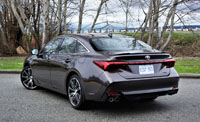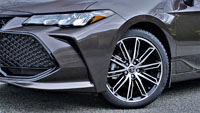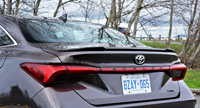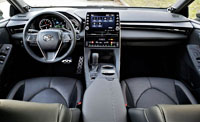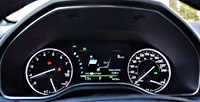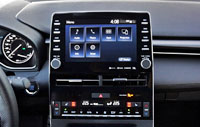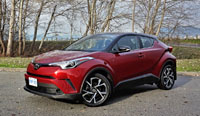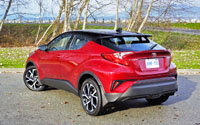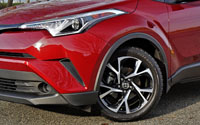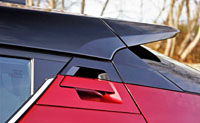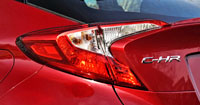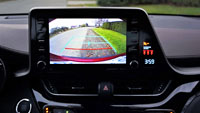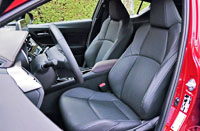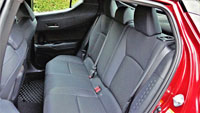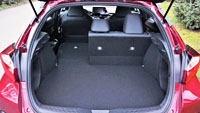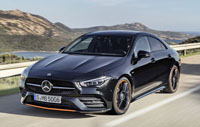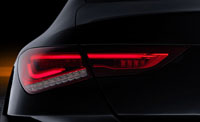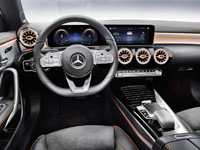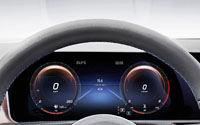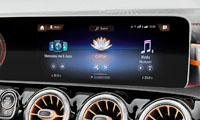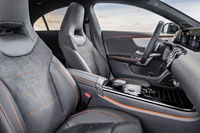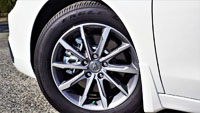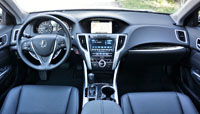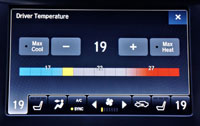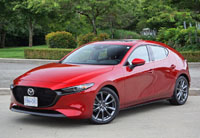
Mazda redesigned its compact 3 for the 2019 model year, and of course I spent a week with one, causing me to declare it as the best car in its compact segment by a long shot. Since then the completely redesigned 2020 Toyota Corolla came on the scene, and while the Mazda3 might still outmuscle the Corolla into the top spot as far as I’m concerned, it’s no longer so far ahead.
As it is, the car I like most and the model, or models the majority of consumers choose to purchase don’t always agree. The current compact sales leader is Honda’s Civic, an excellent car that deserves its success. This said the Civic not only outpaces everything else in the compact segment by a wide margin, but as a matter of fact is also the top-selling car in Canada. Still, it lost 12.8 percent year-over-year in 2019, one of its worst showings in a long time, yet it nevertheless managed to exceed 60,000 units for a total of 60,139. The Corolla came in second after a 2.5-percent YoY downturn that ended with 47,596 units sold, whereas the Hyundai Elantra came in third after dropping 5.5 percent that resulted in 39,463 sales. Where does the Mazda3 fit in? It managed fourth after a shocking 20.4-percent plunge to 21,276 deliveries.

The list of competitors in this class is long and varied, with most backpedalling throughout the previous year, including VW’s Golf that came close to ousting the Mazda3 from fourth place with 19,668 sales after an 8.4-percent downturn, although to be fair to Volkswagen I should probably be pulling its 17,260 Jetta deliveries into the equation after that model’s 14.1 percent growth, resulting in 36,928 compact peoples’ cars (or, in fact, fourth place), while the Kia Forte also grew by 8.0 percent for a reasonably strong 15,549 units. I won’t itemize out the category’s sub-10,000 unit challengers, but will say that some, including Chevy’s Cruze and Ford’s Focus, have now been discontinued.
As for why I’m reviewing a 2019 model so far into this 2020 calendar year? Last year’s supply is still plentiful throughout the country in most trims. I can’t say exactly why this is so, but it’s highly likely that Mazda Canada didn’t fully plan for last year’s slowdown in take-rate. Either way you now have the opportunity of some savings when purchasing a 2019, this being a worthwhile endeavour being that the new 2020 model hasn’t changed much at all, whether we’re talking about the base four-door sedan or sportier hatchback model. As you can clearly see I’m now writing about the five-door Sport in this review, but take note I’ll cover the four-door sedan soon. I’ve tested two top-tier GT trims in both front- and all-wheel drive (FWD and AWD) for this review, so I’ll make sure to go over most important issues, particularly my driving experience with Mazda’s i-Activ AWD system in this low-slung sporty car.
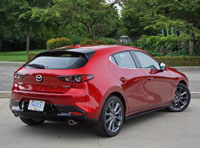
With respect to any 2019 Mazda3 Sport discounts, our 2019 Mazda Mazda3 Sport Canada Prices page shows up to $1,000 in additional incentives in comparison to $750 if opting for the newer model shown on our 2020 Mazda Mazda3 Sport Canada Prices page. There isn’t much difference from year to year, but you’ll likely be able to negotiate a bigger discount if you have maximum information, so therefore keep in mind that a CarCostCanada membership provides dealer invoice pricing that gives you the edge when haggling with your local retailer. Of course, this knowledge could leave thousands in your wallet whether trading up or just trying to get a simple deal, plus CarCostCanada also gives access to the latest manufacturer rebates and more. Be sure to check it out before visiting your local dealer.
Before heading to your dealer it’s also good to know that five-door Sport trims are the same mechanically to the four-door Mazda3 sedan, which means that both 2.0-litre and 2.5-litre SkyActiv four-cylinder engines are available. The base mill makes 155 horsepower and 150 lb-ft of torque, whereas the larger displacement engine is good for 186 horsepower and an identical 186 lb-ft of torque, while a six-speed manual is standard across the entire line, even top-tier GT trim, and a six-speed automatic is optional. The manual offers a fairly sporty short throw and easy, evenly weighted clutch take-up, whereas the auto provides manual shifting capability plus a set of steering wheel-mounted paddles when upgrading to GT trim. Both gearboxes come standard with a drive mode selector that includes a particularly responsive Sport setting, while the new i-Activ AWD system can only be had with the automatic transmission.
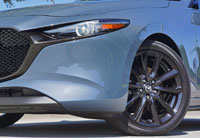
The Mazda3 Sport GT comes standard with proximity-sensing keyless entry for 2020, which was part of the optional Premium package that my 2019 tester included. The upgrade adds a nicer looking frameless centre mirror for 2020 too, plus satin chrome interior trim, but then again the 2019 version shown in the gallery was hardly short of nicely finished metals.
Model year 2019 Mazda3 Sport trims include the GX ($21,300), the mid-range GS ($24,000) and the top-tier GT ($25,900). The base 2.0-litre engine is only in the GX model, whereas the 2.5-litre mill is exclusive to both GS and GT trim lines. The automatic gearbox adds $1,300 across the line, while i-Activ AWD increases each automatic-equipped trims’ bottom line by $1,700.
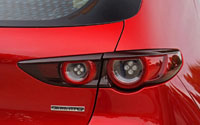
Both engines include direct injection, 16 valves and dual-overhead cams, plus various SkyActiv features that minimize fuel usage, the bigger 2.5-litre motor featuring segment-exclusive cylinder-deactivation. Both engines utilize less expensive regular unleaded gasoline too, the 2.0-litre achieving a claimed Transport Canada five-cycle rating of 8.7 L/100km in the city, 6.6 on the highway and 7.8 combined when mated to the base manual gearbox, or 8.6 in the city, 6.7 on the highway and 7.7 combined when conjoined to the auto. The 2.5-litre, on the other hand, is said to be capable of 9.2 L/100km city, 6.6 highway and 8.1 combined with its manual transmission, 9.0, 6.8 and 8.0 respectively with the autobox, or 9.8, 7.4 and 8.7 with AWD.
The top-line engine doesn’t use much more fuel when considering its power advantage. Of course, the minor difference in fuel economy would widen if one were to drive the quicker car more aggressively, which is tempting, but I only pushed my two weeklong test cars for short durations, and merely to test what they could do. I was grateful the red FWD car with the black cabin was fitted with the standard six-speed manual gearbox, and the grey AWD model with the red interior was upgraded to the six-speed automatic with paddles, thus providing very different driving experiences.

Before I get into that, the Mazda3 GT offers a superb driving position, which isn’t always true in this economically targeted compact class. The GT Premium’s 10-way powered driver’s seat, which includes powered lumbar support and is also part of the GS trims’ feature set when upgraded to its Luxury package, is wonderfully comfortable with good lateral support and excellent lower back support. Even better, the car’s tilt and telescoping steering column offers very long reach, which is important as I have a longer set of legs than torso. I was therefore able to pull the Mazda3 Sport’s steering wheel further rearward than I needed, allowing for an ideal driver’s position that maximized comfort and control.
There’s plenty of space and comfortable seating in back as well, with good headroom that measured approximately three and a half inches over my crown, plus I had about four inches in front of my knees, more than enough space for my feet below the driver’s seat when it was set up for my five-foot-eight body. Also, there were four inches from my outer hip and shoulder to the rear door panel, which was ample, and speaking of breadth I imagine there’d be more than enough space to seat three regular-sized adults on the rear bench, although I’d rather not have anyone bigger than a small child in between rear passengers.
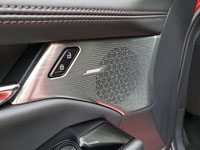
Mazda provides a wide folding armrest with two integrated cupholders in the middle, but the 3 Sport doesn’t get a lot of fancy features in back, like overhead reading lamps, air vents, heatable outboard seats, and USB charge points (or for that matter any other kind of device charger).
I found the dedicated cargo area large enough for my requirements, plus it was carpeted up the sidewalls and on the backsides of each 60/40 split folding seat. Unfortunately Mazda doesn’t include any type of pass-through down the middle, which is the same for most rivals, but the hard-shell carpeted cargo cover feels like a premium bit of kit and was easily removable, although take note that it must either be reversed and placed on the cargo floor to be stowed away, or slotted behind the front seats. Altogether, the 3 Sport allows for 569 litres behind those rear seats, or 1,334 litres when they’re laid flat, which is pretty good for this class.

The Mazda3 impresses even more when it comes to interior quality and refinement. Its styling is more minimalist than opulent, but this said few volume-branded compacts come anywhere as close to providing such a premium-level car. For instance, its entire dash top and each door upper gets covered in a higher grade of padded composite material than the class average, while the instrument panel facing and door inserts are treated to an even more luxurious faux leather with stitching. One of my testers’ cabins was even partially dyed in a gorgeous dark red, really setting it apart from more mainstream alternatives.
I’ve been fond of the latest Mazda3 since first testing it in the previously noted sedan body style, particularly the horizontal dash design theme that’s visually strengthened by a bright metal strip of trim spanning the entire instrument panel from door to door. It cuts right through the dual-zone automatic climate control interface, and provides a clean and tidy lower framing of the vents both left and right. This top-line model adds more brushed metal, including beautifully drilled aluminum speaker grilles plus plenty of satin-aluminized trim elsewhere. Mazda continues its near-premium look and feel by wrapping the front door uppers in the same high-quality cloth as the roofliner.

Visually encircled by an attractive leather-wrapped sport steering wheel, its rim held in place by stylish thin spokes adorned with premium-quality metal and composite switchgear, the 3’s gauge cluster is a mix of analogue dials to the outside and pure digital functionality within, organized into Mazda’s classic three-gauge design. The speedometer sides in the middle, and thus is part of the 7.0-inch display that also includes a variety of other functions. It’s not as comprehensively featured as some others, but all the important functions are included.
The 8.8-inch main display is sits upright like a wide, narrow tablet, yet due to its low profile the screen is smaller than average. Some will like it and some won’t, particularly when backing up, as the rearview camera needed extra attention. The camera is clear with good resolution, while its dynamic guidelines are a helpful aid, but I’m used to larger displays.

All other infotainment features work well, with Mazda providing a minimalist’s dream interface that’s merely white writing on a black background for most interface panels, except navigation mapping, of course, which is as bright and colourful as most automakers in this class, as was for the satellite radio display that provided cool station graphics. Unfortunately there’s no touchscreen for tapping, swiping and pinching features, the system only controlled by a rotating dial and surrounding buttons on the lower console, which while giving the 3 a more premium look and feel than most rivals, isn’t always as easy to use. I was able to do most things easily enough, however, such as pairing my smartphone via Android Auto (Apple CarPlay is standard as well).
Being that so many 2019 Mazda3 trims are still available, I’ll give you a full rundown of the aforementioned upgrade packages, with the GS trim’s Luxury package adding the 10-way powered driver’s seat with memory noted before, as well as leatherette upholstery, an auto-dimming centre mirror, and a power glass sunroof with a manual-sliding sunshade. Incidentally, GT trim comes standard with the auto-dimming rearview mirror and moonroof and offers an optional Premium package that swaps out the faux leather upholstery for the real deal and also adds the power/memory driver’s seat, plus it links the exterior mirrors to the memory seat while adding auto-dimming to the driver’s side.
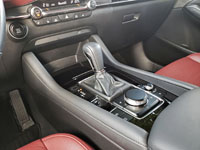
Additionally, the GT Premium package adds 18-inch alloys in a black metallic finish, a windshield wiper de-icer, proximity keyless access, a windshield-projected colour Active Driving Display (ADD) (or in other words a head-up display/HUD), rear parking sonar, a HomeLink garage door opener, satellite radio (with a three-month trial subscription), SiriusXM Traffic Plus and Travel Link services (with a five-year trial subscription), the previously noted navigation system, and Traffic Sign Recognition (TSR), a host of advanced driver assistance systems (ADAS) including Smart Brake Support Rear (SBS-R) that automatically stops the car if it detects something in the way (like a curb, wall or lighting standard), and Smart Brake Support Rear Crossing (SBS-RC) that does the same albeit after detecting a car or (hopefully) a pedestrian, these last two features complementing the Smart Brake Support (SBS) and Smart City Brake Support (SCBS) automatic emergency braking from the GS, plus that mid-range model’s Distance Recognition Support System (DRSS), Forward Obstruction Warning (FOW), forward-sensing Pedestrian Detection, Lane Departure Warning System (LDWS), Lane-keep Assist System (LAS), Driver Attention Alert (DAA), High Beam Control System (HBC), and last but hardly least, Radar Cruise Control with Stop & Go. Incidentally, the base GX model features standard Advanced Blind Spot Monitoring (ABSM) with Rear Cross Traffic Alert (RCTA), which means those inside a Mazda3 GT with its Premium package are well protected against any possible accident.

Now that we’re talking features, the base GX includes standard LED headlights, LED tail lamps, front and rear LED interior lighting, pushbutton start/stop, an electromechanical parking brake, three-way heated front seats, Bluetooth phone/audio connectivity, SMS text message reading/responding capability, plus more, while I also appreciated the sunglasses holder in the overhead console that’s standard with the GS, which protects lenses well thanks to a soft felt lining, not to mention the GS model’s auto on/off headlamps (the GX only shuts them off automatically), rain-sensing wipers, heatable side mirrors, dual-zone auto HVAC, and heated leather-clad steering wheel rim.
As for the GT, its standard Adaptive (cornering) Front-lighting System (AFS) with automatic levelling and signature highlights front and back make night vision very clear, while its 12-speaker Bose audio system delivered good audio quality, and the 18-inch rims on 215/45 all-season tires would have without doubt been better through the corners compared to the GX and GS models’ 205/60R16 all-season rubber on 16-inch alloys.
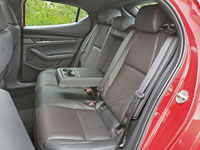
Sportiest GT trim makes do with a slightly firmer ride than the lower trims, but it was never harsh. Better yet is its impressive road-holding skill, the 3 GT always providing stable, controlled cornering and strong, linear braking even though it only uses a simple front strut, rear torsion beam suspension configuration. Take note the 2020 Corolla and Civic mentioned earlier come with fully independent suspension designs.
As you might imagine, the 2.5-litre four-cylinder has a lot more fire in the belly than the 2.0-litre mill, while its Sport mode made a big difference off the line and during passing procedures. The automatic transmission’s manual mode only needs you to pull the shift lever to engage, while the aforementioned steering wheel shift paddles work best when choosing manual mode, but don’t need it in order to change gears. This said the DIY manual shifts so well you may want to pocket the $1,300 needed for the automatic and shift on your own.
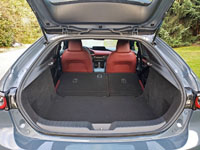
Thanks to the grippy new optional AWD system, takeoff is immediate with no noticeable front wheel spin, which of course isn’t the case with the FWD car, especially in inclement weather. It also felt easier to control through curves at high speeds in both wet and dry weather, but I must admit that my manual-equipped FWD tester had its own level of control that simply couldn’t be matched with an automatic when pushed hard. As much as I liked the manual, I’d probably choose AWD so I wouldn’t be forced to put on chains when heading up the ski hill or while traveling through the mountains during winter.
Everything said, the Mazda3 is a great choice for those who love to drive, plus it’s as well made as many premium-branded compact models, generously outfitted with popular features, a strong enough seller so that its resale value stays high, impressively dependable, and impressively safe as per the IIHS that honoured the U.S. version with a Top Safety Pick award for 2019. That it’s also one of the better looking cars in the compact class is just a bonus, although one that continues to deliver on that near-premium promise Mazda has been providing to mainstream consumers in recent years.
Story and photo credits: Trevor Hofmann


